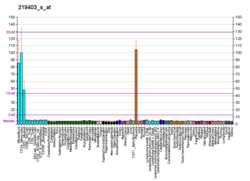HPSE
Внешний вид
| Бу мәкаләгә башка Википедия мәкаләләре сылтамыйлар. Зинһар, ярдәмчене кулланып, кабул ителгән киңәшләргә күрә сылтамалар куегыз.
|
HPSE (ингл. ) — аксымы, шул ук исемдәге ген тарафыннан кодлана торган югары молекуляр органик матдә.[20][21]
Искәрмәләр
[үзгәртү | вики-текстны үзгәртү]- ↑ 1,0 1,1 UniProt
- ↑ Vlodavsky I., Levy-Adam F., Ilan N. Heterodimer formation is essential for heparanase enzymatic activity // Biochem. Biophys. Res. Commun. — Academic Press, Elsevier BV, 2003. — ISSN 0006-291X; 1090-2104 — doi:10.1016/S0006-291X(03)01478-5 — PMID:12927802
- ↑ GOA
- ↑ Okada Y., Yamada S., Toyoshima M. et al. Structural recognition by recombinant human heparanase that plays critical roles in tumor metastasis. Hierarchical sulfate groups with different effects and the essential target disulfated trisaccharide sequence // J. Biol. Chem. / L. M. Gierasch — Baltimore [etc.]: American Society for Biochemistry and Molecular Biology, 2002. — ISSN 0021-9258; 1083-351X; 1067-8816 — doi:10.1074/JBC.M206510200 — PMID:12213822
- ↑ I Vlodavsky, Y Friedmann, M Elkin et al. Mammalian heparanase: gene cloning, expression and function in tumor progression and metastasis // Nat. Med. — NPG, Springer Science+Business Media, 1999. — ISSN 1078-8956; 1546-170X — doi:10.1038/10518 — PMID:10395325
- ↑ 6,00 6,01 6,02 6,03 6,04 6,05 6,06 6,07 6,08 6,09 6,10 6,11 6,12 6,13 6,14 6,15 6,16 6,17 6,18 6,19 6,20 6,21 6,22 6,23 GOA
- ↑ 7,0 7,1 Vlodavsky I., Levy-Adam F., Ilan N. et al. Heparanase uptake is mediated by cell membrane heparan sulfate proteoglycans // J. Biol. Chem. / L. M. Gierasch — Baltimore [etc.]: American Society for Biochemistry and Molecular Biology, 2004. — ISSN 0021-9258; 1083-351X; 1067-8816 — doi:10.1074/JBC.M402131200 — PMID:15292202
- ↑ 8,0 8,1 Vlodavsky I., Brenner B. Heparanase enhances the generation of activated factor X in the presence of tissue factor and activated factor VII // Haematologica — Ferrata Storti Foundation, 2010. — ISSN 0390-6078; 1592-8721; 1138-0381 — doi:10.3324/HAEMATOL.2010.023713 — PMID:20634491
- ↑ Poon I., Hulett M. D. Histidine-rich glycoprotein binds heparanase and regulates its enzymatic activity and cell surface interactions // Int. J. Biochem. Cell Biol. — Elsevier BV, 2010. — ISSN 1357-2725; 0020-711X; 1878-5875 — doi:10.1016/J.BIOCEL.2010.05.008 — PMID:20561914
- ↑ 10,0 10,1 Okada Y., Yamada S., Toyoshima M. et al. Structural recognition by recombinant human heparanase that plays critical roles in tumor metastasis. Hierarchical sulfate groups with different effects and the essential target disulfated trisaccharide sequence // J. Biol. Chem. / L. M. Gierasch — Baltimore [etc.]: American Society for Biochemistry and Molecular Biology, 2002. — ISSN 0021-9258; 1083-351X; 1067-8816 — doi:10.1074/JBC.M206510200 — PMID:12213822
- ↑ Vlodavsky I., Levy-Adam F., Ilan N. et al. Processing and activation of latent heparanase occurs in lysosomes // J. Cell Sci. — The Company of Biologists, 2004. — ISSN 0021-9533; 1477-9137 — doi:10.1242/JCS.01068 — PMID:15126626
- ↑ 12,0 12,1 Yu D., Li R. W. Heparanase in primary human osteoblasts // J. Orthop. Res. — Wiley, 2010. — ISSN 0736-0266; 1554-527X — doi:10.1002/JOR.21138 — PMID:20309870
- ↑ 13,0 13,1 13,2 Livstone M. S., Thomas P. D., Lewis S. E. et al. Phylogenetic-based propagation of functional annotations within the Gene Ontology consortium // Brief. Bioinform. — OUP, 2011. — ISSN 1467-5463; 1477-4054 — doi:10.1093/BIB/BBR042 — PMID:21873635
- ↑ Vlodavsky I., Ilan N., Gingis-Velitski S. et al. Heparanase induces endothelial cell migration via protein kinase B/Akt activation // J. Biol. Chem. / L. M. Gierasch — Baltimore [etc.]: American Society for Biochemistry and Molecular Biology, 2004. — ISSN 0021-9258; 1083-351X; 1067-8816 — doi:10.1074/JBC.M400554200 — PMID:15044433
- ↑ Malgouries S., Donovan M., Thibaut S. et al. Heparanase 1: a key participant of inner root sheath differentiation program and hair follicle homeostasis // Experimental Dermatology — Wiley-Blackwell, 2008. — ISSN 0906-6705; 1600-0625 — doi:10.1111/J.1600-0625.2008.00739.X — PMID:18557927
- ↑ M Toyoshima, M Nakajima Human heparanase. Purification, characterization, cloning, and expression // J. Biol. Chem. / L. M. Gierasch — Baltimore [etc.]: American Society for Biochemistry and Molecular Biology, 1999. — ISSN 0021-9258; 1083-351X; 1067-8816 — doi:10.1074/JBC.274.34.24153 — PMID:10446189
- ↑ Vlodavsky I., Levy-Adam F., Ilan N. et al. Heparanase induces vascular endothelial growth factor expression: correlation with p38 phosphorylation levels and Src activation // Cancer Res. / G. C. Prendergast — American Association for Cancer Research, 2006. — ISSN 0008-5472; 1538-7445 — doi:10.1158/0008-5472.CAN-05-1811 — PMID:16452201
- ↑ Vlodavsky I. Heparanase mediates cell adhesion independent of its enzymatic activity // FASEB J. — FASEB, 2003. — ISSN 0892-6638; 1530-6860 — doi:10.1096/FJ.02-0773COM — PMID:12773484
- ↑ Vlodavsky I. Heparanase mediates cell adhesion independent of its enzymatic activity // FASEB J. — FASEB, 2003. — ISSN 0892-6638; 1530-6860 — doi:10.1096/FJ.02-0773COM — PMID:12773484
- ↑ HUGO Gene Nomenclature Commitee, HGNC:29223 (ингл.). әлеге чыганактан 2015-10-25 архивланды. 18 сентябрь, 2017 тикшерелгән.
- ↑ UniProt, Q9ULJ7 (ингл.). 18 сентябрь, 2017 тикшерелгән.
Чыганаклар
[үзгәртү | вики-текстны үзгәртү]- Степанов В.М. (2005). Молекулярная биология. Структура и функция белков. Москва: Наука. ISBN 5-211-04971-3.(рус.)
- Bruce Alberts, Alexander Johnson, Julian Lewis, Martin Raff, Keith Roberts, Peter Walter (2002). Molecular Biology of the Cell (вид. 4th). Garland. ISBN 0815332181.(ингл.)
| Бу — аксым турында мәкалә төпчеге. Сез мәкаләне үзгәртеп һәм мәгълүмат өстәп, |

